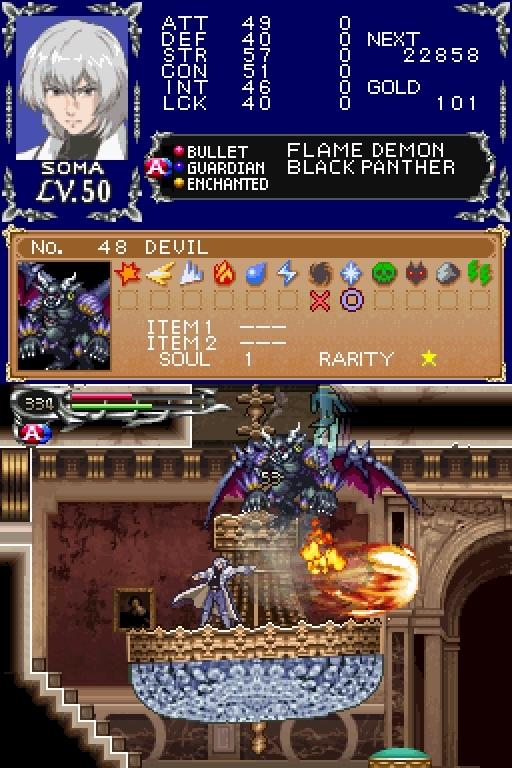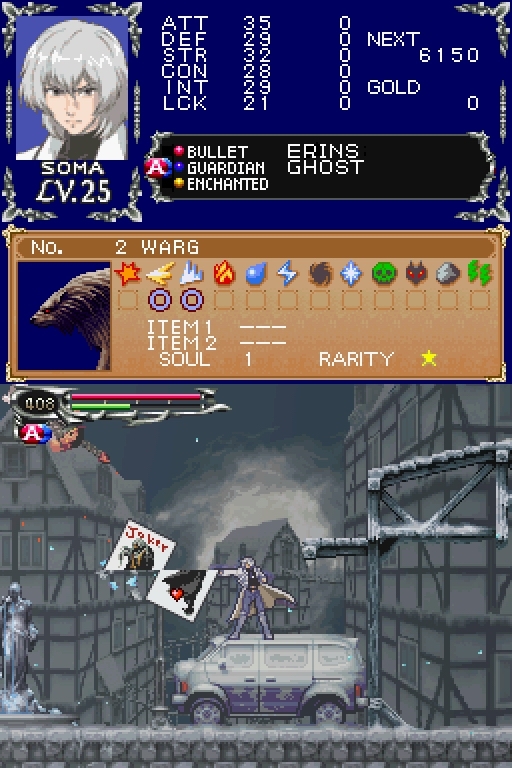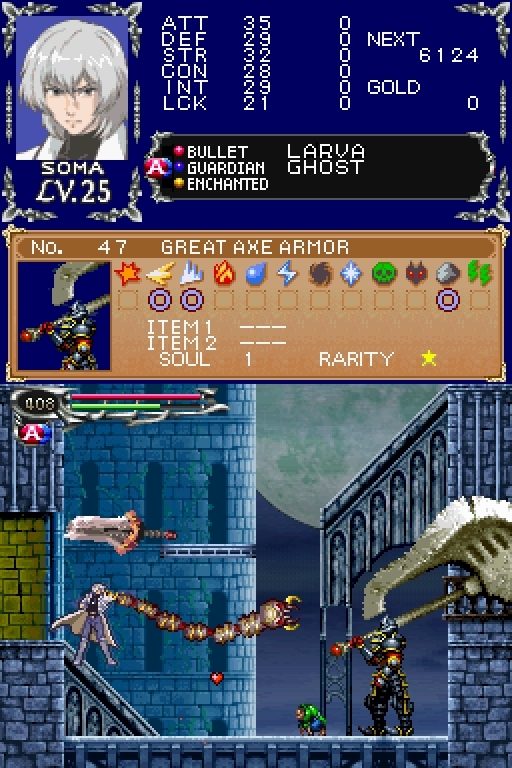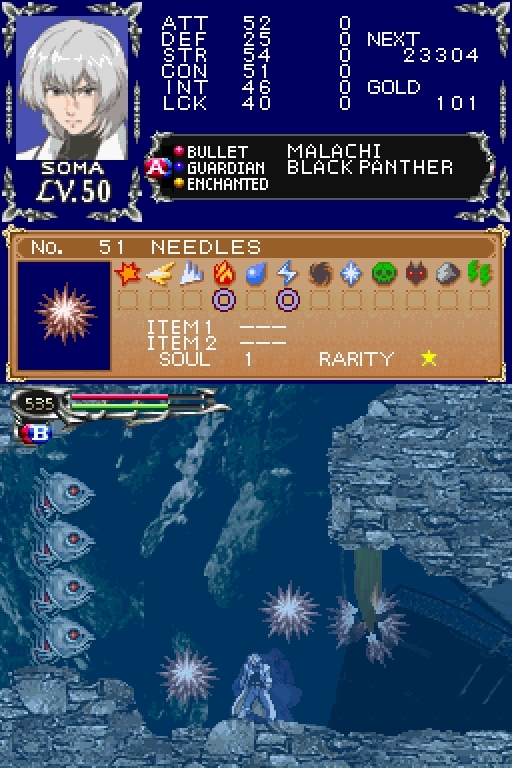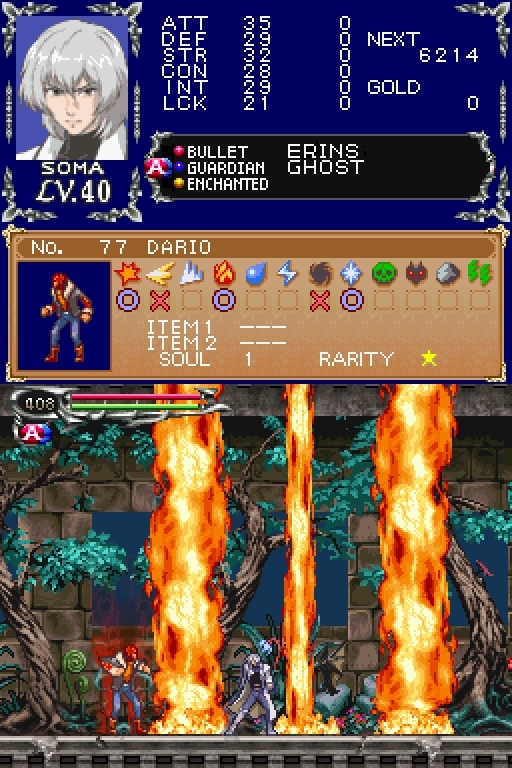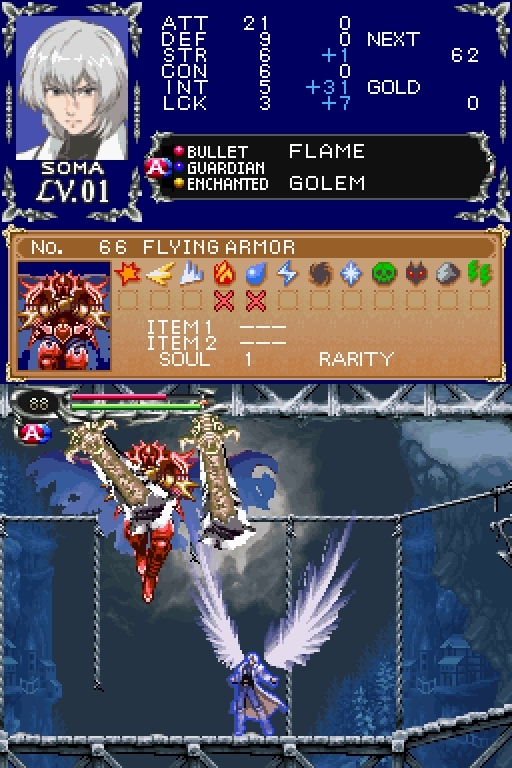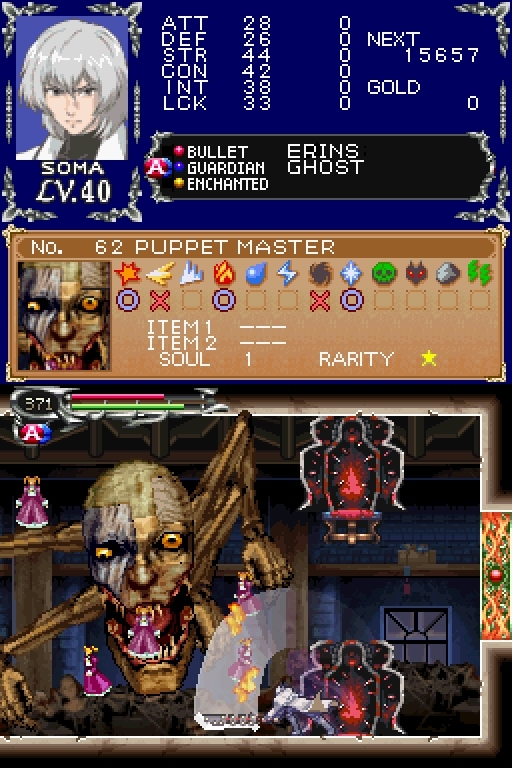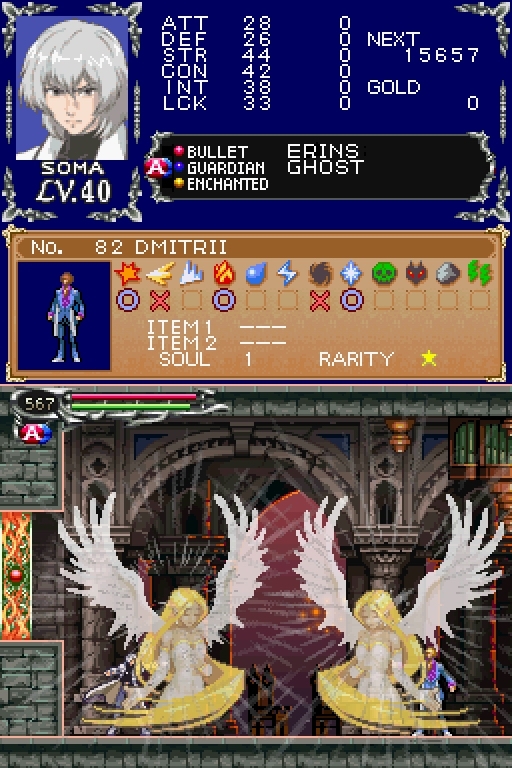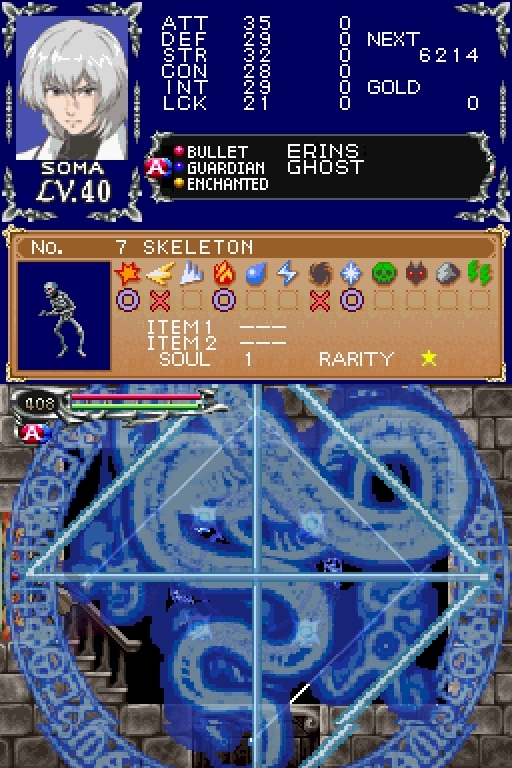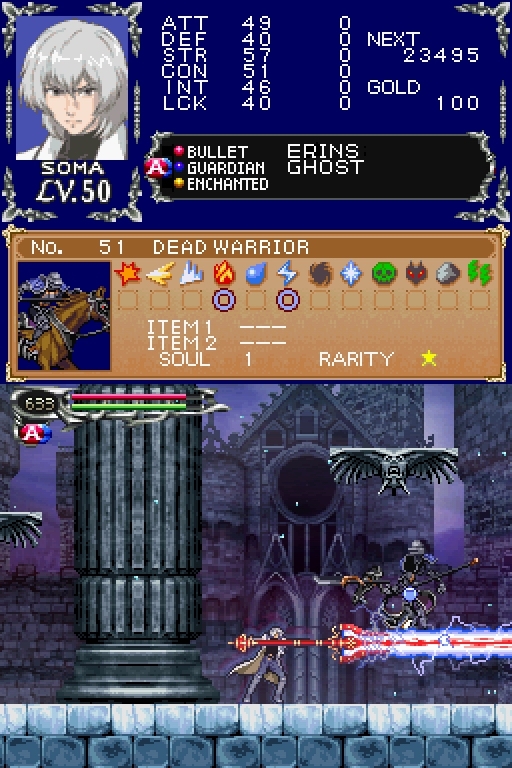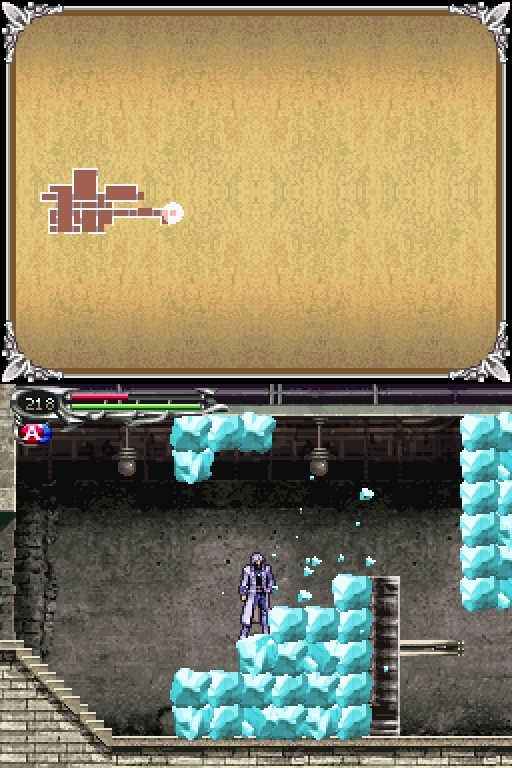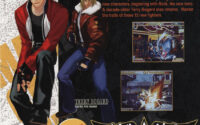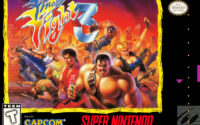Castlevania: Dawn of Sorrow Review
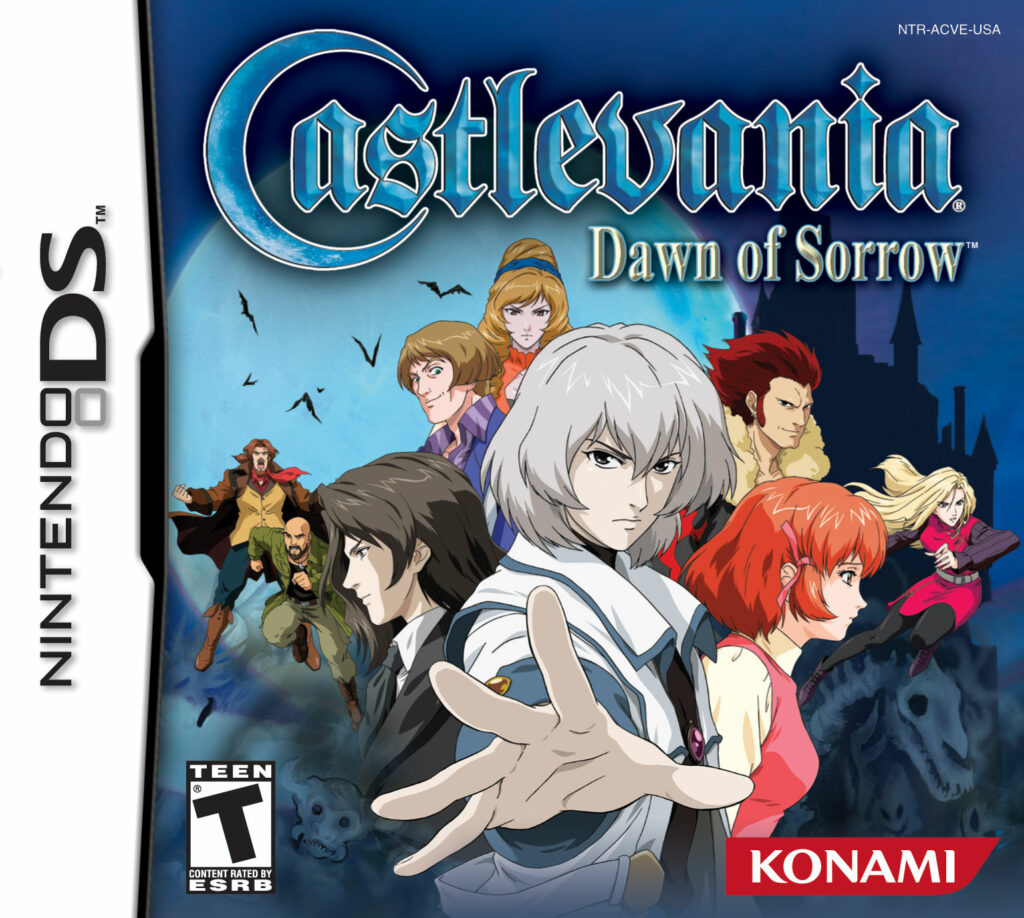
Side-scrolling vampire hunting that’s sure to leave an impression with amazing sound and 2D graphics.
Story
The 19 year old Soma Cruz is the rebirth of Dracula. With the ability to dominate souls of living creatures he possesses a huge potential to become the next incarnation of the dark lord. About a year ago he learned that he was targeted by a cultist leader who made claims that Soma was about to be initialized into the cult and undergo a dark ritual that would unleash the power of the Evil Lord that brews inside him. Celia Fortner, the cultist priestess has gathered up other potential dark lord successors and told them that the last one of them standing will become the next dark lord! If all else fails, she plans to kill Soma and thus unleash what’s inside him. Soma Cruz on the other hand promises to put an end to the madness! He makes haste after Celia and the vampire hunters that pursue her, as he feels that he has a key role in the coming events.
The Game
Castlevania: Dawn of Sorrow is a sequel to the Game Boy Advance game Castlevania: Aria of Sorrow released in 2003. Once again, you play as Soma Cruz – a young man with a very dark destiny. Your goal in the game is to explore a huge, dark castle in which many secrets lie in order to hunt down and defeat the evil cult and its followers. Along the way you will encounter many deadly traps and hideous monsters.
The game is in essence a 2D side scrolling platform game with a distinct dark and gothic theme. Like in many other Castlevania games, you’re free to explore a castle and the game allows the screen to scroll in all eight directions. The game is open-ended to a certain degree, meaning that there is no set path that you must go. Instead you are encouraged to explore the castle on your own. The castle has many secret rooms and pretty much resembles a multilayered labyrinth.
Content
In his quest, Soma is supported by two vampire hunters as well as Yoko Belnades, a knowledgeable expert when it comes to esoteric wisdom and creatures of the dark. Luckily the merchant Hammer also stays nearby, providing Soma with the latest news and deals. At Hammer’s place you can buy and sell items, weapons and armor. Yoko will also help you infuse captured souls into weapons. Doing this will upgrade your weapons, and is pretty much required to stand a chance against the tougher monsters.
Throughout the game you will collect experience points and gold from defeating monsters. The experience points will translate into levels for your character, and as your character rise in levels, he will become stronger. The gold comes in various values and can be used to buy new weapons and other useful items at the merchant such as healing potions and antidotes.
There are 50 different weapons or so, around 30 different armors and around 30 accessories in the game that you can equip to better your chances against the monsters that lurk in the castle. There are stats for your character like Strength, Constitution, Intelligence and Luck etc that you can boost by equipping different weapons and armors.
Each weapon has a special attack and a normal attack. The special attacks are powerful but using them drains your Magic Points. Magic Points are replenishing over time, but collecting heart power-ups will fill your Magic Points up faster.
Thanks to Soma’s ability to dominate other creatures, he has an ability that allows him to absorb souls and copy their powers. Sometimes (depending on your Luck stat) when you kill a monster, you’ll automatically absorb its soul. Most souls come in one of the three different types called Bullet-, Guardian- and Enchant-type. You can equip souls much like you can equip items, and this allows you to use the powers of that soul. Doing this will grant you either a new attack, a familiar, or enhance one of your abilities, or even give you a new ability depending on what type the souls is. This means that if you absorb and equip the soul of a bone throwing skeleton for example, you will gain the ability to throw bones at enemies. The game has over 100 different monsters to fight such as zombies, demons, sea-monsters, ghosts, werewolves etc and practically each one can drop a soul that is unique to that type of monster.
These soul powers are often more prominent than your mundane weapons and armor and they play a key role throughout the whole game. You will need to switch soul powers according to what challenges you face – and you’ll probably find your own favorites.
Most monsters have weaknesses against certain types of attacks and matching your soul powers to what enemies you face is therefor a good practice and is certainly of great importance. Using these powers does drain your Magic Points quickly, so tactical thinking is required to reach the full potential of them.
What’s more, it’s absolutely necessary to use the soul powers of the boss monsters to proceed in the game. The castle is filled with obstacles that can only be overcome by using boss monster’s soul powers. For example there’s a soul that gives you freedom to move under water, another one that transforms you into a bat and one that gives you the ability to do high somersault jumps.
When you defeat a boss you must seal their powers by drawing a magic seal with your stylus on the screen. How you draw the seal will be shown before the boss fight, and if you fail to perform the correct seal the soul will not be contained and instead the boss regains some health and continues fighting. Normally the seals are easy to perform according to the instructions given, but when the more advanced seals are to be performed you need to practice your timing because if you are too slow, the seal will automatically fail.
Because of the open-ended style of this game, there’s always a chance that you will encounter obstacles that you can’t overcome in your current state. When this happens you generally need to turn back and look for the boss monster that will give you the soul power needed to come by that obstacle so that you can proceed in your quest. This means that you will be running back and forth through the same routes quite a few times.
The whole game takes place in the castle, but even so there are numerous environments to explore such as a winding tower, the outdoors surrounding the castle, a wicked garden, haunted guest rooms, underwater caverns and even other dimensions. The game has three possible endings, but the only ending that is considered good is the one that is the hardest to reach. The easiest ending can be reached in about seven hours of game time (excluding replays due to deaths) but if you want to reach the good ending you will probably spend around ten hours instead.
When you reach the good- or the not-so-good ending you will unlock a new game mode called “Julius Mode” where you play as the veteran vampire hunter Julius Belmont known from previous Castlevania games, which is a whole new experience in itself. Julius can’t absorb souls and thus the game is more straightforward, and harder to beat. This game mode effectively doubles the length of the game and is a nice reward for beating the original story mode.
Other game modes in Castlevania: Dawn of Sorrow are the “VS Mode” where you can play a simple level against another player using another DS and another copy of the game. The goal of this mode is to reach the finish line in the least time possible. “Enemy Set Mode” is another feature of the game where you can place enemies of your choice onto the level used in VS Mode, meaning that you can customize the challenge for you and your competitor. Naturally this allows for a rich, unique and replay-friendly experience if you like to challenge other Castlevania players.
You can also trade captured souls with other players and enjoy the game music and sound effects in the unlockable Sound Test Mode.
To further demonstrate your skill, you can try to set your time record in the unlockable “Boss Rush Mode”, in which you will face every boss in the game. The goal here is to beat the all the bosses in the least time possible, and if you’re good you can unlock some bonus items for your character.
Castlevania: Dawn of Sorrow has support for up to three game save files, and you can copy and erase save files at will. It should be noted however, that if you want to play the Julius Mode you must have a save slot free for it even if you do not intend to save your progress in the mode.
Overall the difficulty of the game is just about right – save locations and the portals that allow fast traveling to key locations are evenly spaced throughout the castle. Every time you exit and re-enter an area the monsters in that area will respawn. While it can be annoying it can also be used to your advantage if you need to kill a specific type of monster when you’re hunting for specific souls.
The annoyances in Castlevania: Dawn of Sorrow are minor. It’s a cheap trick of the developers to design the game in a manner that forces you to run back and forth through the same places multiple times. Some of the boss fights can really annoy an impatient player to hell, but you’ll always be able to save nearby to allow for some quick retries at the boss if you should need it – granted that you find the save spot before you enter the boss room. Some enemies are extremely annoying and use poisoning, curses and even petrification – only to annoy you as a player (or so it seems).
There is an automatic mapping feature where you’ll see an overview map of the castle and where you have been, but you’ll be faced with many types of obstacles that you can’t overcome before you have beaten a certain boss, which makes it hard to keep track of what’s what. To further add to the disorientation there are numerous bonus rooms, and many of those bonuses aren’t very helpful. The game isn’t always clear about what you should do and where you should go in order to make progress, and that can certainly be discouraging.
Controls
The controls are easy to cope with and easy to learn. Jumping and attacking with pixel precision is the name of the game and it is just beautifully responsive. Sure, the stylus implementation where you draw the magic seals may be a gimmick that doesn’t add much. There are occasions in the game where you are required to perform many acrobatic moves and do high precision jumps. Normally these aren’t a problem, but when monsters swarm around you it can frustratingly hard.
Graphics
The graphics in this game are very well done. It’s colorful but still maintains a creepy look. The animations are fluid and amazingly well done. The game engine utilizes some clever use of simple sprite rotations and scaling, but a great deal of the animation is hand drawn and it just looks great. You can’t really grow tired of looking at well animated and detailed 2D graphics!
The various stages all have their own atmosphere to them. In later parts it shows that the level design has suffered some loss in details but it’s very minor and most people will probably not even notice it.
The game is full with neat details and the monsters are the stuff of nightmares, but the bosses of this game really stand out as creative and interesting.
Sound
The music is also brilliant in this game. There are some classic Castlevania songs included in the mix, but the whole soundtrack is pretty much solid and appropriate for the setting. The music typically adheres to the minor scales but can occasionally have an up beat “fighting-spirit” in them, which has become typical to Castlevania music. All the 28 songs in the game are good and tones the game towards a darker mood.
There is some voice acting in the game as well but it doesn’t have any major focus – most of it is just screams and cries but they are well produced and further enhances the gritty feel in the game.
Summary
Castlevania: Dawn of Sorrow is certainly a great game worthy of the Castlevania series. It has lots of content and allows for both weapon customization and exploration in an exotic haunted castle. Its shortcomings are close to none, but you need a certain degree of patience to be able to master the game.
The game has some interesting plot twists with its three possible endings, and the gameplay is pretty addicting for as long as it lasts. The sound and graphics are top-notch but the additional game modes doesn’t add much to the overall experience. If you’re into Castlevania however, you wouldn’t want to miss out on this one.
